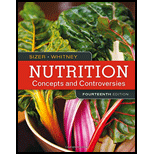
Nutrition: Concepts and Controversies
14th Edition
ISBN: 9781305886865
Author: Sizer, Frances , WHITNEY, Ellie
Publisher: Cengage Learning
expand_more
expand_more
format_list_bulleted
Concept explainers
Question
Chapter 6, Problem 15SC
Summary Introduction
Concept Introduction:
The celiac disease is a condition in which the body is incapable of digesting the gluten. It is a very serious autoimmune disorder. In this case, the gluten intake can lead to the damage to the small intestine.
Expert Solution & Answer
Want to see the full answer?
Check out a sample textbook solution
Chapter 6 Solutions
Nutrition: Concepts and Controversies
Ch. 6 - Prob. 1RQCh. 6 - Prob. 2RQCh. 6 - Prob. 3RQCh. 6 - Prob. 1CTCh. 6 - Prob. 2CTCh. 6 - The basic building blocks for protein are a....Ch. 6 - Prob. 2SCCh. 6 - Prob. 3SCCh. 6 - Some segments of a protein strand coil, somewhat...Ch. 6 - Prob. 5SC
Ch. 6 - Prob. 6SCCh. 6 - Prob. 7SCCh. 6 - Prob. 8SCCh. 6 - Prob. 9SCCh. 6 - Prob. 10SCCh. 6 - Prob. 11SCCh. 6 - The following are complementary proteins: pot...Ch. 6 - Prob. 13SCCh. 6 - Prob. 14SCCh. 6 - Prob. 15SCCh. 6 - Prob. 16SCCh. 6 - Prob. 17SCCh. 6 - Prob. 18SCCh. 6 - Prob. 19SCCh. 6 - Prob. 20SC
Knowledge Booster
Learn more about
Need a deep-dive on the concept behind this application? Look no further. Learn more about this topic, health-nutrition and related others by exploring similar questions and additional content below.Similar questions
Recommended textbooks for you
 Medical Terminology for Health Professions, Spira...Health & NutritionISBN:9781305634350Author:Ann Ehrlich, Carol L. Schroeder, Laura Ehrlich, Katrina A. SchroederPublisher:Cengage Learning
Medical Terminology for Health Professions, Spira...Health & NutritionISBN:9781305634350Author:Ann Ehrlich, Carol L. Schroeder, Laura Ehrlich, Katrina A. SchroederPublisher:Cengage Learning Comprehensive Medical Assisting: Administrative a...NursingISBN:9781305964792Author:Wilburta Q. Lindh, Carol D. Tamparo, Barbara M. Dahl, Julie Morris, Cindy CorreaPublisher:Cengage Learning
Comprehensive Medical Assisting: Administrative a...NursingISBN:9781305964792Author:Wilburta Q. Lindh, Carol D. Tamparo, Barbara M. Dahl, Julie Morris, Cindy CorreaPublisher:Cengage Learning- Understanding Health Insurance: A Guide to Billin...Health & NutritionISBN:9781337679480Author:GREENPublisher:Cengage

Medical Terminology for Health Professions, Spira...
Health & Nutrition
ISBN:9781305634350
Author:Ann Ehrlich, Carol L. Schroeder, Laura Ehrlich, Katrina A. Schroeder
Publisher:Cengage Learning


Comprehensive Medical Assisting: Administrative a...
Nursing
ISBN:9781305964792
Author:Wilburta Q. Lindh, Carol D. Tamparo, Barbara M. Dahl, Julie Morris, Cindy Correa
Publisher:Cengage Learning

Understanding Health Insurance: A Guide to Billin...
Health & Nutrition
ISBN:9781337679480
Author:GREEN
Publisher:Cengage

